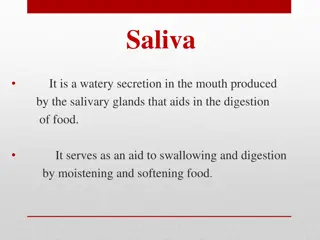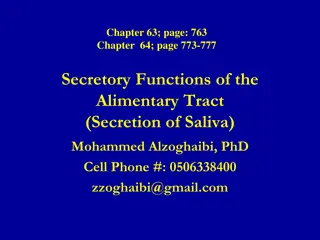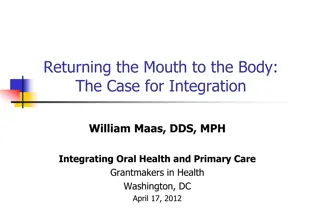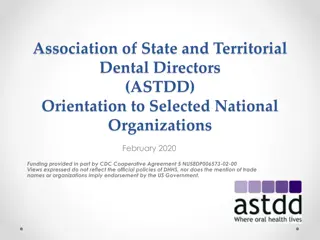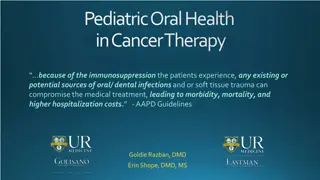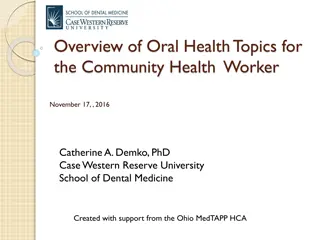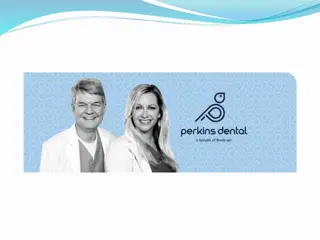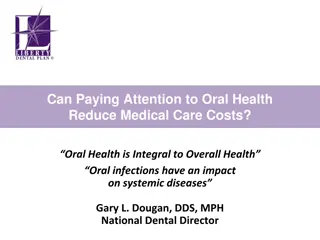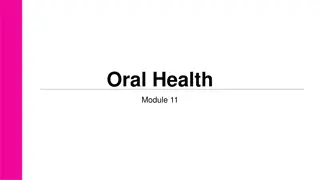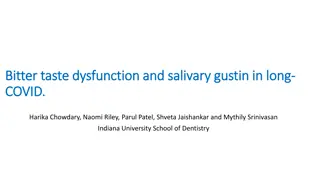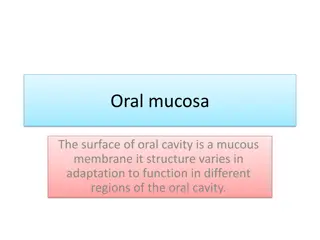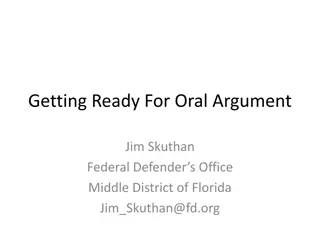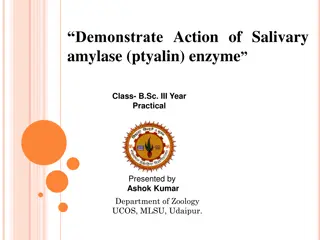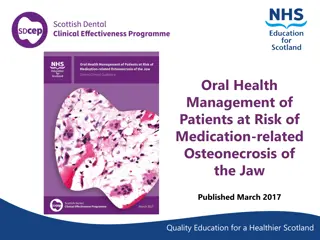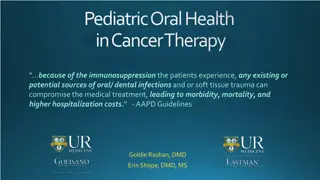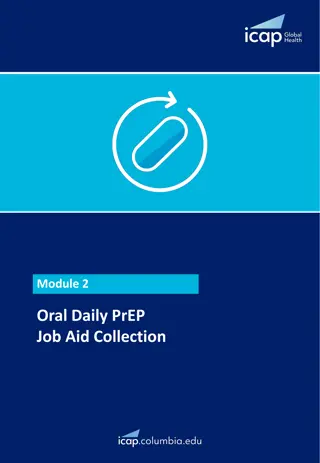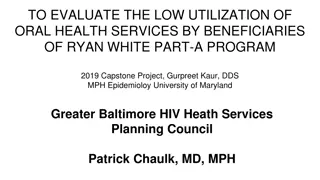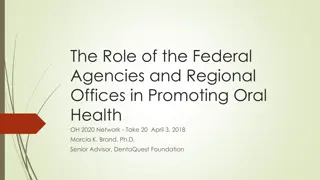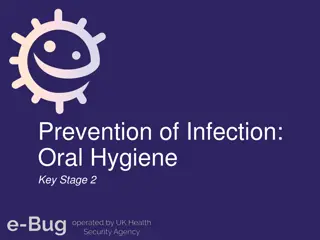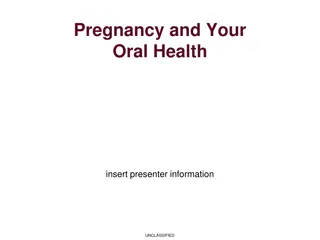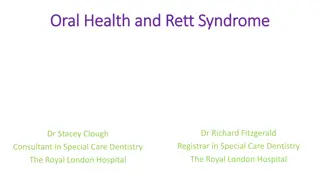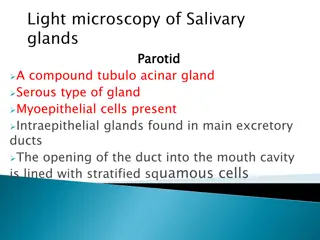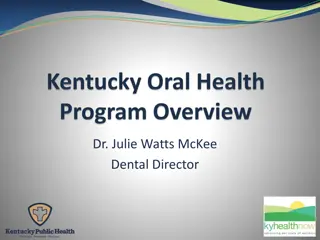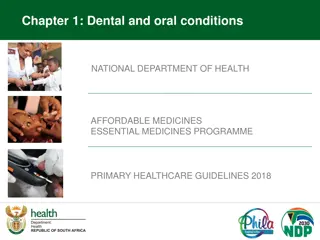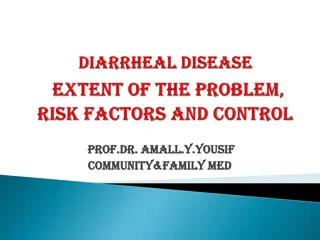Understanding the Importance of Saliva in Oral Health
Saliva plays a crucial role in maintaining oral health by lubricating the mouth, aiding in digestion, serving as an ion reservoir for teeth remineralization, enhancing taste perception, facilitating food clearance, and contributing to the maintenance of healthy oral tissues. Different salivary glands produce varying types of saliva with unique functions, collectively ensuring proper oral hygiene and protecting against dental issues like caries. This comprehensive guide highlights the functions and significance of saliva in oral care.
Download Presentation

Please find below an Image/Link to download the presentation.
The content on the website is provided AS IS for your information and personal use only. It may not be sold, licensed, or shared on other websites without obtaining consent from the author. Download presentation by click this link. If you encounter any issues during the download, it is possible that the publisher has removed the file from their server.
E N D
Presentation Transcript
Saliva and dental caries Dr. Rihab Abdul Hussein Ali B.D.S , M.Sc. , PhD.
Saliva is the glandular secretion which constantly bathes the teeth and the oral mucosa. Pure saliva secreted by the oral glands is sterile until it is discharged onto the mouth. Salivary glands are exocrine glands and are classified according to the nature of their secretion or their duct system. Of the major salivary glands, parotid glands are the largest; the submandibular gland is smaller than the parotid glands. The sublingual gland is composed of several smaller glands. The minor glands situated on the tongue, palate and buccal and labial mucosa. These glands produce 10% of the total volume of saliva.
The function of the minor salivary glands is also important since about 70 % of the total volume of salivary proteins is secreted by them. They also contribute fluoride that bathes the teeth and enhances caries resistance. The parotid glands are serous glands; upon stimulation, they produce watery saliva with high content of enzymes like amylase and lipase, while the secretions of sublingual glands are predominantly mucous, mucin-rich fluids, as same as of minor salivary glands. While the secretions of submandibular glands are a mixture of mucous and serous fluids.
The word saliva is synonymous with spittle, whole saliva, mixed saliva and oral fluid. Oral fluid which include all the fluid present in the mouth and it is made by secretion of salivary glands, gingival crevicular fluid, food debris, microorganisms, human cells, desquamated oral epithelia, transudate of the mucous membrane and mucous from nasal cavity and pharynx, sometimes it may include acid from the stomach in cases of gastric reflux.
Function of saliva: - Lubrication (Coats mucosa and helps to protect against mechanical, thermal irritation. Assists speech and swallowing). - Digestion (The presence of amylase enzyme in saliva which aid in breaking down of starchy food). - Ion reservoir (Solution supersaturated with ions facilitate remineralization of the teeth). - Taste (saliva acts as solvent for substances thus allowing interaction of foodstuffs with taste buds to facilitate taste). - Clearance (clears food and facilitates swallowing). and chemical
- Maintenance of healthy oral tissues. - Buffer capacity (helps to neutralize plaque pH after eating, thus reducing time for demineralization). - Route of excretion for many substances (This is a very inefficient excretory pathway as reabsorption may occurs further down the intestinal tract). - Antimicrobial actions (help control the oral microflora by specific and non-specific immune components). - Agglutination (Aggregation and accelerated clearance of bacterial cells). - Water balance.
Oral clearance The oral cavity is frequently exposed to substances with potentially harmful properties. Some of these substances have a direct influence on the caries process. An important function of saliva is therefore to dilute and eliminate substances. This is a physiological process usually referred to as salivary clearance. The total volume of saliva spread out in a thin film on teeth and mucosa varies depending on several factors, but is usually small, 0.8 1.2 ml.
Since the mucosal surface area of the oral cavity is approximately 200 cm2, the saliva film is only about 100 m thick and varies between sites in the oral cavity. For example, the film is only about 10 min the palate and it has been shown that individuals experiencing xerostomia often have a saliva film less than that. The saliva film is moving slowly towards the throat with a speed varying from about 1 to 8 mm/min, the slowest movement is in the front of the upper jaw and the fastest in the lower jaw. The main stream of saliva goes over the floor of the mouth at each side of the tongue with little exchange between the two streams.
Composition of saliva The composition of saliva varies, depending on whether it is stimulated or unstimulated (resting). Stimulated saliva is secreted in response to masticatory or gustatory stimulation, or to other less common stimuli such as vomiting center. While unstimulated saliva is the mixture of secretions which enter the mouth in the absence of exogenous stimuli. The submandibular gland secretes the greatest proportion of the unstimulated saliva (69%) followed by the parotid, sublingual and minor glands.
Saliva is composed of about 99.5%water and 0.5% solid of which about half is inorganic (chloride, bicarbonate, phosphate, sodium, calcium, potassium, trace elements, and dissolved carbon dioxide, oxygen, and nitrogen) and about half is organic (proteins, vitamins, lipids, hormone like substances, free amino acids, urea, as well as microbial and shed cells, and antimicrobial substances).
Calcium is distributed in saliva as ionized calcium and bound calcium. At pH values close to normal the ionized calcium comprises approximately 50% of the total calcium concentration. The most important ions for maintaining the ionic strength of saliva are sodium, potassium and chloride. Sodium and chloride are reabsorbed to an extent that depends on the salivary flow rate during the passage of the saliva down the salivary duct. The higher the salivary flow rate, the fewer ions are reabsorbed.
Factors influencing salivary composition 1- Flow rate: It is the main factor affecting the composition of saliva. The concentration of constituents varies between stimulated and unstimulated flow rate of saliva. As the flow rate increases, the pH and other constituents like protein, sodium, calcium, chloride and bicarbonate rise. While other constituents fall (magnesium, potassium and phosphate). 2- Glandular source: The parotid glands normally contribute 20% of the total volume of unstimulated saliva, while at high flow rate the parotid glands contribute 50% of the whole saliva. 3- Duration of stimulation: The saliva collected for two minutes will have a different composition from saliva collected for 10-15 minutes. Bicarbonate, protein and calcium concentration increases with duration of stimulation whereas decreased chloride.
4- Nature of stimulus: The taste of salts stimulated much higher protein content. Acid is the most potent stimulus for salivary secretion and leads to production of an alkaline saliva. The pH of saliva is dependent mainly on the flow rate and is independent of the nature of the stimulus. The secretion of salivary glands is mainly controlled by parasympathetic impulses from the salivary nuclei. Sympathetic impulses are more likely to influence salivary composition by increasing exocytosis from certain cells. 5- Others like medications (Antidepressants, diuretics, antihistamines and narcotics), various diseases (Autoimmune diseases, diabetes mellitus, salivary glands stones, malnutrition) and exercises.
Salivary flow rate Flow rate is the most important clinical parameter of saliva affecting dental caries susceptibility. A reduced salivary flow rate results in reduced defense capacity and increased susceptibility to oral diseases. A low flow rate can affect oral sugar clearance negatively, reducing salivary pH, and influencing the concentrations of various salivary components in particular the antimicrobial factors. A total volume of about 0.5 - 1 liters of saliva is secreted daily.
Hyposalivation is not the same thing as xerostomia. Hyposalivation describing a condition where the flow rates of saliva are abnormally low. The cut-off value for unstimulated whole saliva flow rate is 0.1 ml/min and that of paraffin-chewing stimulated whole saliva is 0.5 0.7 ml/min (for women and men, respectively). These flow rates are significantly lower than the generally accepted normal values in healthy individuals of around 0.3 ml/min for the unstimulated whole saliva flow rate and 1.5 ml/min for the chewing stimulated one. Both rates showed a wide range. It should be noted that taste stimulation, especially sour taste, results in much higher flow rates.
Xerostomia may exist without the patient fulfilling the criteria for the diagnosis of hyposalivation and hyposalivation may be symptomless, although xerostomia most often is associated with low saliva flow rates. In general, healthy individuals with a normal salivary flow rate can experience xerostomia, like those breathing through the mouth. Xerostomia is a common condition in population. It s reported that 25 % of general population complain of xerostomia or symptoms associated with it. For elderly, the incidence is as high as 40 %. Xerostomia patients should be instructed to observe a variety of caries preventive procedures, including oral hygiene instruction, plaque control, low sugar dietary advice, daily use of topical fluoride (0.05 %), professional applied of fluoride, antimicrobial mouth rinses, uses of artificial saliva and placement of sealants.
Factors influencing salivary flow rate 1- Age: The flow rate increases gradually with age. 2- Gland size: Flow rate is less in females than for males due to a larger size of glands among males. 3- Nature of stimulus: Mechanical stimulation leads to increase salivation. 4- Medications like antidepressants, antihypertensive reduce salivary flow rate. 5- Other factors like circadian (Sodium and chloride levels peak in the early morning while the peak protein is in the late afternoon) and circannual rhythms (flow is lower in warm weather and higher in cold), body position; a person when standing will have a higher flow rate than sitting and when a person is lying down. It s almost zero during sleep.
Influence of saliva on dental caries The presence of saliva is important for the health of both oral soft and hard tissues. The complexity of physical and chemical composition of salivary secretions performs a considerable number of protective functions in addition to other functions. The influence of saliva on the caries process is fundamental; the anti-caries effects of saliva can be categorized as static or dynamic. The static effects are those which may be assumed to be exerted continuously, throughout the day and include effects on bacterial composition of plaque through antibacterial or metabolic factors, protective effects of pellicle formation, and effects of salivary ions in maintaining a supersaturated environment for the tooth mineral.
Dynamic effects, on the other hand, are those that are mobilized over the time-course of the Stephan curve. These include the clearance of the carbohydrate challenge and of the acid products of plaque metabolism, and the alkalinity and buffering power to restore plaque pH towards neutrality. These dynamic effects are related to the level of salivary stimulation, and are thus activated during eating or drinking, i.e., approximately when their action is required.
Saliva enhances the clearance of cariogenic microorganisms from the mouth, not only by its flushing effect, but also by bacteria agglutination. Saliva may remineralizeearly carious lesion by its calcium and phosphate ions. Remineralization is remarkably enhanced by the presence of fluoride. Inorganic components of saliva (calcium, phosphate, fluoride) increase the resistance of hydroxyapatite against cariogenic challenge and enhance the saturation of plaque fluid with respect to the tooth surface structure. 1. 2. 3.
4. Salivary buffering effect (bicarbonate, phosphate and some protein systems which not only have a buffer effect but also provide ideal conditions for automatically eliminating certain bacterial components that require a very low pH to survive). The buffering systems in saliva (buffer is a solution that tend to maintain constant pH) have different pH ranges of maximal buffering capacity, the phosphate and bicarbonate systems have pH of 6.8 - 7.0 and 6.1 - 6.3 respectively.
Bicarbonate may buffer against pH fall, thus plays an important role in the protection against dental caries. The bicarbonate found in saliva is present as a result of carbohydrate metabolism, through anaerobic glycolysis and the citric acid cycle. When an acid is added bicarbonate release a weak carbonic acid, which rapidly decompose to water and carbon dioxide that leave the solution. The increase in the carbonic acid concentration lead to more carbon dioxide escape from saliva making it possible for more bicarbonate to bind to hydrogen ions (H+), which will end in the removal of the acid. HCO- + H+ H2CO3 H2O + CO2
The phosphate buffer plays an essential role when salivary flow is low. At a pH greater than 6 the saliva is supersaturated with phosphate with regard to hydroxyapatite (HA) which forms the dental enamel. When the pH falls below the critical level (5.5) the HA begins to dissolve, freeing phosphates that attempt to restore the pH balance. Different individuals may also have different critical pH values owing to interindividual variations in saliva, total calcium and phosphate concentrations. Thus, the critical pH in saliva is not constant, but more a dynamic variable, which varies around a mean pH value of 5.5. Above this value, enamel tends to remineralize.
Certain proteins, such as histatins or sialin, as well as certain alkaline products generated by the metabolic activity of bacteria on amino acids, peptides, proteins and urea, are also important for controlling the pH of the saliva. Maintenance of physiological pH at mucosal cells and tooth surface is an important function of salivary buffers. Hydrogen ion concentration is expressed in pH units; it is equal to the negative logarithm of the hydrogen ion concentration. The value of salivary pH varies is in the range of 6.7 and 7.4.


